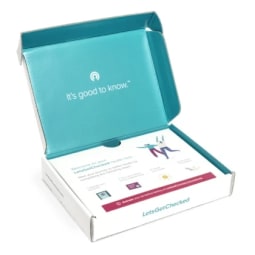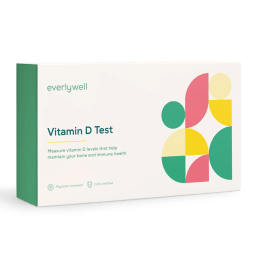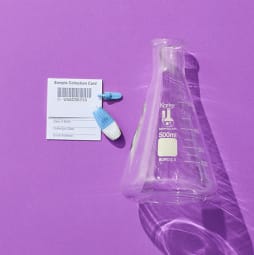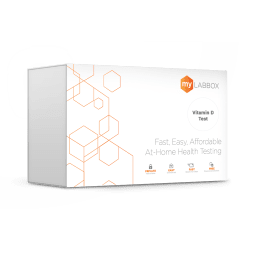Instead, one of the main ways we get this beneficial vitamin is from—you guessed it—exposure to sunlight. However the length of time needed to get enough vitamin D differs by person (season, latitude, skin tone, etc.), and it may require partaking in unsafe skin practices to reach the optimal amount. Considering how much of our time is spent sitting indoors at a desk or watching Netflix on the couch, it’s no surprise that many people are still struggling to hit the recommended vitamin D intake levels of at least 3,000 IU per day (which is still on the low end). If you’re curious about your own vitamin D levels, you can ask your doctor for a lab biomarker for vitamin D status called the serum total 25-hydroxyvitamin D test, i.e., the 25(OH)D test, to shed some light on the situation. When an appointment with your health care professional isn’t an option, an at-home vitamin D test is another way to test your vitamin D levels from the comfort of your home. Below, learn everything you need to know about at-home vitamin D tests, as well as what counts as a vitamin D deficiency. Along with supporting thyroid health2, it also helps both the innate and adaptive immune systems by promoting white blood cell function3 and aiding the immune system in defending against threats4. It also plays a role in gut health, supporting beneficial gut bacteria and the gut mucosal lining. Finally, vitamin D is key to healthy bones and strong muscles. It helps the body absorb calcium, which is essential for bones, and supports the body in maintaining a balance between calcium and phosphorus. Needless to say, it’s not something you want to be deficient in—and lack of the vitamin has been linked to bone, thyroid2, autoimmune5, and mood issues, to name just a few. The Endocrine Society7 defines vitamin D deficiency as the level of 25-hydroxyvitamin (25(OH)D) of less than 20 ng/ml, and vitamin D insufficiency as a 25(OH)D result of less than 30 ng/ml. In other words, these are the baseline cutoffs for avoiding insufficiency and thus, numbers to avoid. Indeed, many health care experts and much scientific research push for levels closer to 50 ng/ml to support bone health, immunity, and whole-body health. For example, the Endocrine Society recommends a preferred range of 40 to 60 ng/ml; founder and director of the Anti-Aging & Longevity Center of Philadelphia Seema Bonney, M.D., recommends an optimal range of 55 to 60 ng/ml given the importance of the micronutrient—and she’s not the only one. Board-certified endocrinologist Brittany Henderson, M.D., previously told mbg that the common 30 ng/ml baseline actually leaves clients underserved, and she personally recommends a higher level. “As an endocrinologist, I know that achieving optimal serum 25(OH)D levels in the 50+ ng/ml range is imperative for immune health, bone health, and more,” she explained. “Our population is heavily vitamin D deficient, and targeting an optimal level of 50 ng/ml has an enormous impact on all aspects of human health.” We receive vitamin D (vitamin D2 and vitamin D3) from foods, beverages, sun exposure, and certain supplements. That vitamin D is converted in our liver to 25(OH)D, the biomarker for vitamin D status in your body. You might also see this test referred to as the calcidiol 25-hydroxycholecalciferol test. The other type of vitamin D in our bloodstream and acting inside our cells is 1,25-dihydroxyvitamin D, which is the biologically active, hormone-like form. This doubly hydroxylated form of the nutrient is created when 25(OH)D is further converted by our kidneys and targeted tissues for use in the body. This form, also known as calcitriol, isn’t typically measured by tests (except in a kidney disease clinical setting) because it is tightly regulated and does not stay in the body as long as 25(OH)D. At-home vitamin D tests are typically shipped directly to your home and require you to mail back any samples within a required time frame for accuracy; some options with vial samples may ask for a same-day return to prevent the blood from clotting. Sounds easy enough, right? As with any at-home tests, there are pros and cons to testing vitamin D at home versus in a lab or at a doctor’s office. The first advantage, of course, is ease. “One of the benefits of at-home testing is that you can take the test when it’s convenient for you,” explains Bonney. “Even if your doctor doesn’t feel it’s medically necessary to have this test done, with an at-home test you can still get the data to supplement as warranted.” However, it’s important to feel supported in understanding your results, which will vary from company to company. “Like any other lab testing, you’ll get a reference range, which doesn’t tell you what optimal levels are,” says Bonney. “These ranges are typically based on what most people are, not what they should be. Doing the test under the guidance of a physician who is focused on making sure you have the right amount of vitamin D is helpful to guide what your dosage of supplementation should be.” Another consideration is the margin for error. Leaving the test to a professional means you’re not responsible for potential error (i.e., inherent variability) in your results. Some reviewers of at-home tests complain that they were unable to properly collect their sample—although typically companies are good about sending a replacement kit in these instances. However, most of the at-home testing companies on this list do accept payment from a Flexible Spending Account (FSA) or Health Savings Account (HSA), if those are insurance benefits available to you. Your vitamin D test result levels will be available within five days either on the patient portal or the LetsGetChecked app. A nurse will call you if there’s any cause for concern in your results. As mentioned, you can also reach out to the helpline to chat with a nurse if you have any questions. Like the rest of the tests on this list, this one only tests vitamin D (ok, 25(OH)D if we’re being technical). For an additional $20, Let’sGetChecked also offers an Essential Vitamin Test that checks vitamin B12 and E levels, in addition to vitamin D. Although this kit is pricier than some of the other options on this list, it offers the added value of support from a health care practitioner. One reviewer notes, “I had a phone call with a technician who summarized the results of my blood test. He was very sensitive and considerate but also very concise and clear regarding the results of my test and their meaning.” A common complaint about Let’sGetChecked is the amount of blood you’re asked to provide with the finger prick. It’s a small vial, but if you’re squeamish about blood, this kit might not be for you. Community Perk: Use the promo code MBG25 to save 25% on your first order. In comparison to some of the others, the price is right for this vitamin D test—and it’s often on sale around major holidays. The biggest difference between this kit and the test from Let’sGetChecked is the lack of nursing staff support. Your Everlywell results will still be physician-reviewed, but there is not a helpline for questions. You can instead watch educational videos on the website or take your results to your health care provider to ask questions and discuss potential next steps. All in all, reviewers have great things to say about this test. Many mention the ease of collection and quick results, including one person who says, “I purchased the Everlywell Vitamin D testing kit after learning my insurance would not cover a vitamin D test with my regular blood work. The testing process was very easy and results were reported within days, and the cost was a fraction of what my normal lab would have charged.” Since they’re not technically a testing company, needed partners with CLIA-certified lab OmegaQuant to create the tests and process the results. You’ll receive a kit with lancets, a blood collection card, and a prepaid return envelope. The test only requires three drops of blood—so if you’re avoiding a larger blood draw from a lab or another test, that’s a perk. On the downside, your results will take significantly longer to process than the other tests on this list (the website says two to three weeks). You also won’t have a physician to review your results before they’re sent back to you. However, needed is a certified B Corp, which means it meets the highest standards for environmental and social performance, as well as legal transparency. It’s also Climate Neutral certified. If your results show any cause for concern, you may be eligible for a free physician consultation—however, it’s not clear on the website what qualifies for this consultation, and the brand may point you in the direction of your health care provider instead. Still, if you’re looking for a straightforward test with speedy results, this kit might be a good option for you. MyLAB Box even offers a six-month subscription option that reduces the price by 15%, which can be an easy way to see the impact of starting a new supplement routine on your levels. Just note that there are only two reviews online for this test, and the general reviews of MyLAB Box are pretty polarizing. “In general, [at-home] vitamin D tests may be as accurate as lab tests done by phlebotomy, but they do need to be performed correctly,” she explains. “This means washing your hands with soap and water (as per the CDC) to remove residue like lotions that can affect the results. It’s also vital that you produce a blood drop sufficient to fill the testing strip; otherwise, you’ll have an insufficient sample.” Other possible variables include waiting too long before the blood sample is sent off and assayed for results, as well as testing method errors at the lab completing the assay, according to mindbodygreen’s vice president of scientific affairs Ashley Jordan Ferira, Ph.D., RDN. “At-home vitamin D tests are really at-home blood samples that are mailed off for vitamin D assay (testing) at certified labs using fancy equipment and analytical methods,” she explains. “While no assay method is 100% free of error, the gold standard method for accurately testing your vitamin D status is called liquid chromatography-tandem mass spectrometry9 (LC-MS/MS).” An at-home test can provide some insight into your biomarkers from the comfort of your own couch. Just be sure to choose a test that makes you feel supported and doesn’t break the bank. And remember: If you’re concerned about the results of your at-home test, it’s best to speak with your health care provider.










